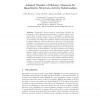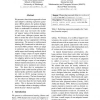684 search results - page 9 / 137 » Biological learning modeled in an adaptive floating-gate sys... |
DIS
2010
Springer
13 years 6 months ago
2010
Springer
Quantitative structure-activity relationships (QSARs) are regression models relating chemical structure to biological activity. Such models allow to make predictions for toxicologi...
ICANN
2005
Springer
14 years 1 months ago
2005
Springer
Humans can recognize biological motion from strongly impoverished stimuli, like point-light displays. Although the neural mechanism underlying this robust perceptual process have n...
ICALT
2006
IEEE
14 years 1 months ago
2006
IEEE
Detecting the needs of learners is a challenging but essential task to be able to provide adaptivity. In this paper we present a tool that enables learning management systems (LMS...
COMPSAC
2006
IEEE
14 years 1 months ago
2006
IEEE
—This paper describes a biologically-inspired network architecture, called SymbioticSphere, which allows large-scale data centers to autonomously adapt to dynamic environmental c...
ACL
2010
13 years 5 months ago
2010
We present a data-driven approach to learn user-adaptive referring expression generation (REG) policies for spoken dialogue systems. Referring expressions can be difficult to unde...


